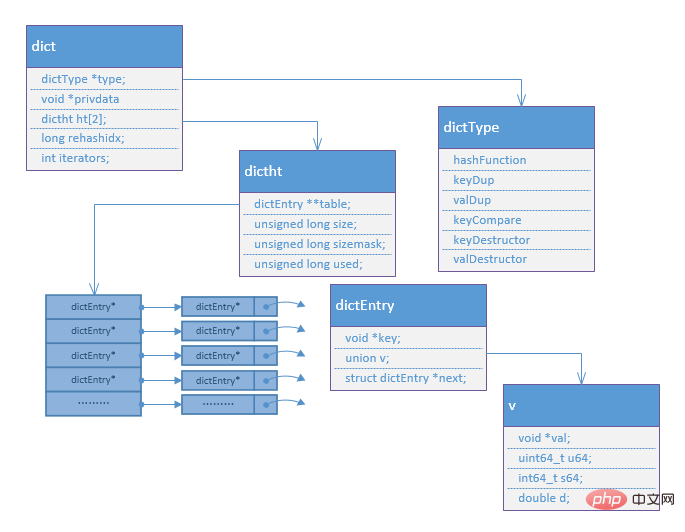redis的hash怎麼實現的

0.前言
redis是KV型的記憶體資料庫, 資料庫儲存的核心就是Hash表, 我們執行select指令選擇一個儲存的db之後, 所有的操作都是以hash表為基礎的, 下面會分析下redis的hash資料結構與實作.
#1.hash資料結構
/*Hash表一个节点包含Key,Value数据对 */
typedef struct dictEntry {
void *key;
union {
void *val;
uint64_t u64;
int64_t s64;
double d;
} v;
struct dictEntry *next; /* 指向下一个节点, 链接表的方式解决Hash冲突 */
} dictEntry;
/* 存储不同数据类型对应不同操作的回调函数 */
typedef struct dictType {
unsigned int (*hashFunction)(const void *key);
void *(*keyDup)(void *privdata, const void *key);
void *(*valDup)(void *privdata, const void *obj);
int (*keyCompare)(void *privdata, const void *key1, const void *key2);
void (*keyDestructor)(void *privdata, void *key);
void (*valDestructor)(void *privdata, void *obj);
} dictType;
typedef struct dictht {
dictEntry **table; /* dictEntry*数组,Hash表 */
unsigned long size; /* Hash表总大小 */
unsigned long sizemask; /* 计算在table中索引的掩码, 值是size-1 */
unsigned long used; /* Hash表已使用的大小 */
} dictht;
typedef struct dict {
dictType *type;
void *privdata;
dictht ht[2]; /* 两个hash表,rehash时使用*/
long rehashidx; /* rehash的索引, -1表示没有进行rehash */
int iterators; /* */
} dict;2.hash資料結構圖

#3.漸進式hash說明
dict中ht[2]中有兩個hash表, 我們第一次儲存資料的資料時, ht[0]會建立一個最小為4的hash表, 一旦ht[0]中的size和used相等, 則dict中會在ht[1]建立一個size*2大小的hash表, 此時並不會直接將ht[ 0]中的資料copy進ht[0]中, 執行的是漸進式rehash, 即在以後的操作(find, set, get等)中慢慢的copy進去, 以後新加入的元素會加入ht[ 0], 因此在ht[1]被佔滿的時候定能確保ht[0]中所有的資料全部copy到ht[1]中.
4.建立hash表
建立hash表過程非常簡單,直接呼叫dictCreate函數, 分配一塊記憶體,初始化中間變數即可.
dict *dictCreate(dictType *type, void *privDataPtr)
{
/*分配内存*/
dict *d = zmalloc(sizeof(*d));
/*初始化操作*/
_dictInit(d,type,privDataPtr);
return d;
}5.新增元素
hash表中新增元素,先判斷空間是否足夠, 然後計算key對應的hash值, 然後將需要添加的key和value放入表中.
int dictAdd(dict *d, void *key, void *val)
{
/*添加入hash表中, 返回新添加元素的实体结构体*/
dictEntry *entry = dictAddRaw(d,key);
if (!entry) return DICT_ERR;
/*元素val值放入元素实体结构中*/
dictSetVal(d, entry, val);
return DICT_OK;
}
/*
*添加元素实体函数
*/
dictEntry *dictAddRaw(dict *d, void *key)
{
int index;
dictEntry *entry;
dictht *ht;
if (dictIsRehashing(d)) _dictRehashStep(d);
/*根据key值计算新元素在hash表中的索引, 返回-1则表示元素已存在, 直接返回NULL*/
if ((index = _dictKeyIndex(d, key)) == -1)
return NULL;
/*如果在进行rehash过程,则新元素添加到ht[1]中, 否则添加到ht[0]中 */
ht = dictIsRehashing(d) ? &d->ht[1] : &d->ht[0];
entry = zmalloc(sizeof(*entry));
entry->next = ht->table[index];
ht->table[index] = entry;
ht->used++;
/*设置元素key*/
dictSetKey(d, entry, key);
return entry;
}
/*
*计算索引的函数
*/
static int _dictKeyIndex(dict *d, const void *key)
{
unsigned int h, idx, table;
dictEntry *he;
/* 判断hash表是否空间足够, 不足则需要扩展 */
if (_dictExpandIfNeeded(d) == DICT_ERR)
return -1;
/* 计算key对应的hash值 */
h = dictHashKey(d, key);
for (table = 0; table <= 1; table++) {
/*计算索引*/
idx = h & d->ht[table].sizemask;
/*遍历冲突列表, 判断需要查找的key是否已经在冲突列表中*/
he = d->ht[table].table[idx];
while(he) {
if (dictCompareKeys(d, key, he->key))
return -1;
he = he->next;
}
if (!dictIsRehashing(d)) break;
}
return idx;
}
/*
*判断hash表是否需要扩展空间
*/
static int _dictExpandIfNeeded(dict *d)
{
/*redis的rehash采用的渐进式hash, rehash时分配了原来两倍的内存空间, 在rehash阶段空间必定够用*/
if (dictIsRehashing(d)) return DICT_OK;
/* hash表是空的需要初始化空间, 默认是4*/
if (d->ht[0].size == 0) return dictExpand(d, DICT_HT_INITIAL_SIZE);
/* 已使用空间满足不了设置的条件*/
if (d->ht[0].used >= d->ht[0].size &&
(dict_can_resize ||
d->ht[0].used/d->ht[0].size > dict_force_resize_ratio))
{
/*扩展空间, 使用空间的两倍*/
return dictExpand(d, d->ht[0].used*2);
}
return DICT_OK;
}
/*
*扩展空间或者初始化hash表空间
*/
int dictExpand(dict *d, unsigned long size)
{
dictht n;
/* 对需要分配大小圆整为2的倍数 */
unsigned long realsize = _dictNextPower(size);
/* 如果空间足够则表明调用错误 */
if (dictIsRehashing(d) || d->ht[0].used > size)
return DICT_ERR;
n.size = realsize;
n.sizemask = realsize-1;
n.table = zcalloc(realsize*sizeof(dictEntry*));
n.used = 0;
/*hash表为空初始化hash表*/
if (d->ht[0].table == NULL) {
d->ht[0] = n;
return DICT_OK;
}
/*新分配的空间放入ht[1], 后面一步一步进行rehash*/
d->ht[1] = n;
d->rehashidx = 0;
return DICT_OK;
}6.查找元素
查找元素過程,首先計算hash值, 然後計算在ht[0]和ht[1]中索引位置, 進行查找.
dictEntry *dictFind(dict *d, const void *key)
{
dictEntry *he;
unsigned int h, idx, table;
if (d->ht[0].size == 0) return NULL;
/*如果正在进行rehash, 执行一次rehash*/
if (dictIsRehashing(d)) _dictRehashStep(d);
h = dictHashKey(d, key);
/*由于可能正在rehash, 因此要从ht[0]和ht[1]中分别进行查找, 找不到返回NULL*/
for (table = 0; table <= 1; table++) {
idx = h & d->ht[table].sizemask;
he = d->ht[table].table[idx];
/*遍历冲突列表查找元素*/
while(he) {
if (dictCompareKeys(d, key, he->key))
return he;
he = he->next;
}
if (!dictIsRehashing(d)) return NULL;
}
return NULL;
}7.刪除元素
刪除元素首先查找元素, 然後將元素從hash表中移除即可, 呼叫dictDelete刪除元素, 會同時刪除元素所佔空間
int dictDelete(dict *ht, const void *key) {
return dictGenericDelete(ht,key,0);
}
static int dictGenericDelete(dict *d, const void *key, int nofree)
{
unsigned int h, idx;
dictEntry *he, *prevHe;
int table;
if (d->ht[0].size == 0) return DICT_ERR;
if (dictIsRehashing(d)) _dictRehashStep(d);
h = dictHashKey(d, key);
for (table = 0; table <= 1; table++) {
idx = h & d->ht[table].sizemask;
he = d->ht[table].table[idx];
prevHe = NULL;
/*查找元素到元素,进行删除操作, 并释放占用的内存*/
while(he) {
if (dictCompareKeys(d, key, he->key)) {
/* Unlink the element from the list */
if (prevHe)
prevHe->next = he->next;
else
d->ht[table].table[idx] = he->next;
if (!nofree) {
dictFreeKey(d, he);
dictFreeVal(d, he);
}
zfree(he);
d->ht[table].used--;
return DICT_OK;
}
prevHe = he;
he = he->next;
}
if (!dictIsRehashing(d)) break;
}
return DICT_ERR; /* not found */
}hash指令
hash指令操作都比較簡單,需要注意的是當我們建立hash表示預設儲存結構,不是dict,而是ziplist結構,可以參考redis之Ziplist資料結構,hash_max_ziplist_entries和hash_max_ziplist_value值作為閥值,hash_max_ziplist_entries表示一旦ziplist中元素數量超過該值,則需要轉換為diccigmaxv_vvmax表示一旦ziplist中資料長度大於該值,則需要轉換為dict結構。
更多Redis相關技術文章,請造訪Redis教學欄位學習!
以上是redis的hash怎麼實現的的詳細內容。更多資訊請關注PHP中文網其他相關文章!

熱AI工具

Undresser.AI Undress
人工智慧驅動的應用程序,用於創建逼真的裸體照片

AI Clothes Remover
用於從照片中去除衣服的線上人工智慧工具。

Undress AI Tool
免費脫衣圖片

Clothoff.io
AI脫衣器

Video Face Swap
使用我們完全免費的人工智慧換臉工具,輕鬆在任何影片中換臉!

熱門文章

熱工具

記事本++7.3.1
好用且免費的程式碼編輯器

SublimeText3漢化版
中文版,非常好用

禪工作室 13.0.1
強大的PHP整合開發環境

Dreamweaver CS6
視覺化網頁開發工具

SublimeText3 Mac版
神級程式碼編輯軟體(SublimeText3)
 redis集群模式怎麼搭建
Apr 10, 2025 pm 10:15 PM
redis集群模式怎麼搭建
Apr 10, 2025 pm 10:15 PM
Redis集群模式通過分片將Redis實例部署到多個服務器,提高可擴展性和可用性。搭建步驟如下:創建奇數個Redis實例,端口不同;創建3個sentinel實例,監控Redis實例並進行故障轉移;配置sentinel配置文件,添加監控Redis實例信息和故障轉移設置;配置Redis實例配置文件,啟用集群模式並指定集群信息文件路徑;創建nodes.conf文件,包含各Redis實例的信息;啟動集群,執行create命令創建集群並指定副本數量;登錄集群執行CLUSTER INFO命令驗證集群狀態;使
 redis怎麼讀取隊列
Apr 10, 2025 pm 10:12 PM
redis怎麼讀取隊列
Apr 10, 2025 pm 10:12 PM
要從 Redis 讀取隊列,需要獲取隊列名稱、使用 LPOP 命令讀取元素,並處理空隊列。具體步驟如下:獲取隊列名稱:以 "queue:" 前綴命名,如 "queue:my-queue"。使用 LPOP 命令:從隊列頭部彈出元素並返回其值,如 LPOP queue:my-queue。處理空隊列:如果隊列為空,LPOP 返回 nil,可先檢查隊列是否存在再讀取元素。
 redis數據怎麼清空
Apr 10, 2025 pm 10:06 PM
redis數據怎麼清空
Apr 10, 2025 pm 10:06 PM
如何清空 Redis 數據:使用 FLUSHALL 命令清除所有鍵值。使用 FLUSHDB 命令清除當前選定數據庫的鍵值。使用 SELECT 切換數據庫,再使用 FLUSHDB 清除多個數據庫。使用 DEL 命令刪除特定鍵。使用 redis-cli 工具清空數據。
 centos redis如何配置Lua腳本執行時間
Apr 14, 2025 pm 02:12 PM
centos redis如何配置Lua腳本執行時間
Apr 14, 2025 pm 02:12 PM
在CentOS系統上,您可以通過修改Redis配置文件或使用Redis命令來限制Lua腳本的執行時間,從而防止惡意腳本佔用過多資源。方法一:修改Redis配置文件定位Redis配置文件:Redis配置文件通常位於/etc/redis/redis.conf。編輯配置文件:使用文本編輯器(例如vi或nano)打開配置文件:sudovi/etc/redis/redis.conf設置Lua腳本執行時間限制:在配置文件中添加或修改以下行,設置Lua腳本的最大執行時間(單位:毫秒)
 redis命令行怎麼用
Apr 10, 2025 pm 10:18 PM
redis命令行怎麼用
Apr 10, 2025 pm 10:18 PM
使用 Redis 命令行工具 (redis-cli) 可通過以下步驟管理和操作 Redis:連接到服務器,指定地址和端口。使用命令名稱和參數向服務器發送命令。使用 HELP 命令查看特定命令的幫助信息。使用 QUIT 命令退出命令行工具。
 redis過期策略怎麼設置
Apr 10, 2025 pm 10:03 PM
redis過期策略怎麼設置
Apr 10, 2025 pm 10:03 PM
Redis數據過期策略有兩種:定期刪除:定期掃描刪除過期鍵,可通過 expired-time-cap-remove-count、expired-time-cap-remove-delay 參數設置。惰性刪除:僅在讀取或寫入鍵時檢查刪除過期鍵,可通過 lazyfree-lazy-eviction、lazyfree-lazy-expire、lazyfree-lazy-user-del 參數設置。
 如何優化debian readdir的性能
Apr 13, 2025 am 08:48 AM
如何優化debian readdir的性能
Apr 13, 2025 am 08:48 AM
在Debian系統中,readdir系統調用用於讀取目錄內容。如果其性能表現不佳,可嘗試以下優化策略:精簡目錄文件數量:盡可能將大型目錄拆分成多個小型目錄,降低每次readdir調用處理的項目數量。啟用目錄內容緩存:構建緩存機制,定期或在目錄內容變更時更新緩存,減少對readdir的頻繁調用。內存緩存(如Memcached或Redis)或本地緩存(如文件或數據庫)均可考慮。採用高效數據結構:如果自行實現目錄遍歷,選擇更高效的數據結構(例如哈希表而非線性搜索)存儲和訪問目錄信
 redis計數器怎麼實現
Apr 10, 2025 pm 10:21 PM
redis計數器怎麼實現
Apr 10, 2025 pm 10:21 PM
Redis計數器是一種使用Redis鍵值對存儲來實現計數操作的機制,包含以下步驟:創建計數器鍵、增加計數、減少計數、重置計數和獲取計數。 Redis計數器的優勢包括速度快、高並發、持久性和簡單易用。它可用於用戶訪問計數、實時指標跟踪、遊戲分數和排名以及訂單處理計數等場景。






